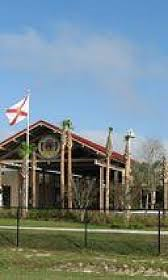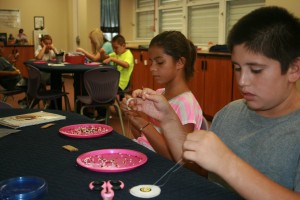
The Pemayetv Emahakv, a K-8 charter school in Florida, teaches students the Seminole Indian reservation's native Creek language and culture.
Enter Central Florida’s Brighton Indian Reservation, past cattle fields and citrus groves, and it doesn’t take long to understand the priorities of this Florida Seminole Indian Tribe.
There’s a casino, but there’s also a new elder affairs building and a star-shaped veterans center ringed with giant bronze statues. And there’s a charter school that’s become the community’s heartbeat.
Inside Pemayetv Emahakv, which means “Our Way,’’ students in kindergarten through eighth grade straddle two worlds – one rooted in their rich, proud heritage; the other in the wider space where they must compete and succeed like their counterparts across the planet.
So they study Creek, the tribe’s native tongue, along with the state’s new science standards. They string Indian beads into necklaces and read books on Kindles. They cook fry bread in chickees and take standardized tests in state-of-the art classrooms.

Students, most of whom are from the Seminole Indian Tribe, learn to string beads into jewelry the same way their ancestors did.
“We wanted a native curriculum,’’ said Michele Thomas, a parent and administrative assistant at the school and a Florida Seminole Indian. “That was the sole purpose. This school was built to save our language.’’
It’s no accident the school is a charter. That’s what gave it the flexibility to offer deep immersion in Seminole culture. It’s no surprise, either, that it’s part of a growing trend of charter schools opening on American Indian reservations across the country.
There are now 31 of them, according to a recent report by the National Alliance for Public Charter Schools. Twelve opened on Bureau of Indian Affairs lands between 2005 and 2010.
Some of the increase is due to a decades-old Congressional moratorium on new schools operated by the federal Bureau of Indian Education, which oversees public schools on American Indian reservations. That meant tribes couldn’t expand existing ones, either.
Charters offered an option.
But much of the growth can be attributed to a desire by American Indians to preserve their fading culture.
“When we were growing up, our grandmas were around,’’ said Cecelia Thomas, a Seminole tribal member and bookkeeper at the school where two of her children attended. “Our uncles were around. Our mom and dad were around. We all lived on the same street or in the same little house. We just seemed to be a tighter-knit family.’’
Customs and language were passed down, from generation to generation. But even Thomas, 45, has lost some of those connections. Like a lot of parents her age on the reservation, she can’t speak her native tongue fluently so she can’t teach it to her children.
Before the charter school, she said, “our language was dying.”